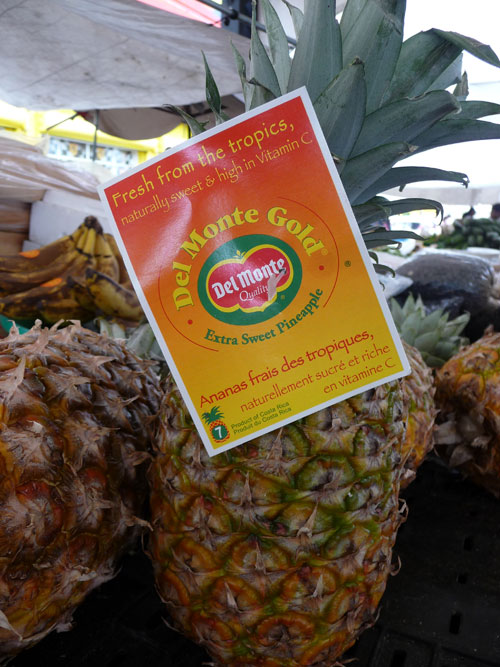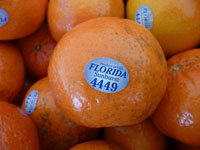I knew what kind of information I wanted to know…but deciding what questions to ask and how to word them has been quite a learning experience for me. At first, I just started talking to people in open markets when I went to Southern Florida in January. It was a testing ground for me to ‘ feel out’ peoples’ interest in my subject and the kind of information they seemed willing to relay to me. This process gave me some direction in which to formulate my survey and gave me confidence in that people did seem genuinely interested in what my research was about. I saw a definite change of attitude in their willingness to discuss their open market food choices, when I told them I was doing a University of Hawaii class research project about what people’ interest is in where their food comes from in open markets. I don’t know if it was because I said I was a university student or because I said I was from Hawaii that made people receptive to talking with me but this introduction granted me a few minutes of welcome conversation. It was a beginning!
From these conversations with people at the market, I came up with a draft of several questions to ask in a printed survey. I passed this survey draft around to Professor Becker ( my UHH research adviser) and several other people I know, for their review and feedback. Actually lots of feedback was given, many hours of revision ensued and the following survey emerged:
Survey for whosyourfarmer.info research project: 20100224
Date of survey: _______________________ Location of survey: ________________________
Aloha! My name is Jan Anderson. I am a student in the Communication Department at the University of Hawaii-Hilo This survey is part of my independent research project, researching what types of food people buy for themselves and their families in open markets, and how much they are interested in: where the food is grown, how the food is grown, who grows the food and the cost of the food they buy there. My research areas include open markets on Hawaii Island ( where I live), and other regions that I will be traveling to within this Spring 2010 semester.
Thank you for taking the time to read my survey , to think about your answers, and to write them down.
1. Where do you shop for most of your fresh food? [ Mark one and answer why]
- farmers market ________________________________________________
- general grocery store _____________________________________________
- health food store _________________________________________________
– other ____________________________________________________________
2. What kinds of food do you come to this farmers market to buy? [ Mark all that you buy]
___ fresh vegetables, fruits, nuts
___dairy (milk, eggs, cheese)
___prepared food (cooked food, honey, jams etc.)
___other________________________________
3. When you buy food, at this farmers market, what are you most interested in?
[ On a scale of 0 to 5 ( 5 being the most important), please circle what is important to you]
a) how the food looks 0 1 2 3 4 5
b) where the food is grown 0 1 2 3 4 5
c) how the food is grown 9 1 2 3 4 5
d) who grows the food 0 1 2 3 4 5
e) price of the food 0 1 2 3 4 5
f) freshness of the food 0 1 2 3 4 5
4.Rate the following ways you like to get information about the food you buy at this farmers market,?
[On a scale of 0 to 5 ( 5 being the most important), please circle what is important to you]
a) talking with the seller ( who is not the farmer) 0 1 2 3 4 5
b) talking with the seller (who is the farmer) 0 1 2 3 4 5
c) signs – with general information 0 1 2 3 4 5
d) labels – detailed information 0 1 2 3 4 5
e) other ______________________
5. Where do you consider locally grown food comes from? [ Mark one ]
___ grown in the district
___ grown in the county
___ grown in the state
___ grown in the country
6. Rate how important to you each of the following choices are when you buy your food ?
[ On a scale of 0 to 5 ( 5 being the most important) please circle what is important to you]
a) locally grown (not organic) 0 1 2 3 4 5
b) organic (grown anywhere) 0 1 2 3 4 5
c) price 0 1 2 3 4 5
7. Demographics: [ please circle one in each section of a, b ,c]
a) gender : _____ female _____ male
b) age _____(18-30) _____(31-40 ) _____ (41-50 ) _____ (51-62) _____(63-70)____(71 +)
c) household income _____ (up to $30,000) _____ ($30,000 to $60.000)
_____ ( $60,000 to $ 80,000)_____ ($80,000 plus)
d) race [choose one or more]:
__ American Indian or Alaskan native __Asian ___Black or African American
__Native Hawaiian __Pacific Islander __ White __ Other
8.Would you be willing to have a personal interview with me, to talk more about your interest in the food you buy at open markets?
_____yes _____no
If yes, then please write your name below and let me know when would be a good time to talk.
Name:__________________________________________________
I appreciate your interest in my research project. You can read more about it on my
web blog : whosyourfarmer.info Thank you, Jan
*****************************************************************************************
Please comment in the reply section at the end of this post.


 There were bananas from Honduras,
There were bananas from Honduras,  pineapple ( Del Monte) from Costa Rica, grapes from Brazil, mango from Ecuador and Peru, watermelon from Guatemala, ah…….. oranges labeled ‘Florida, product of USA’!
pineapple ( Del Monte) from Costa Rica, grapes from Brazil, mango from Ecuador and Peru, watermelon from Guatemala, ah…….. oranges labeled ‘Florida, product of USA’!